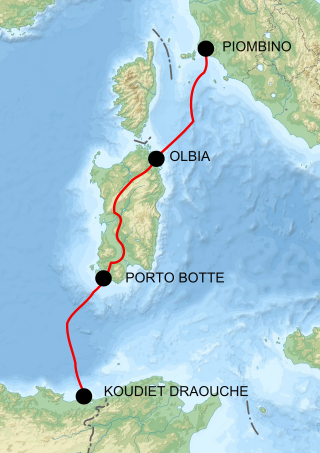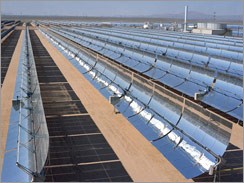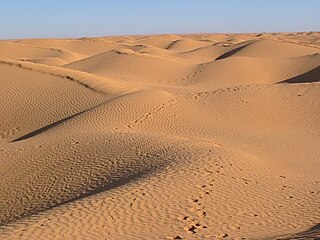
Laghouat is one of the fifty-eight provinces (wilaya) of Algeria. It is located in the north central part of Algeria. The province borders Tiaret Province to the north, El Bayadh Province to the west, Ghardaia Province to the south and Djelfa Province to the east. The capital of the province is Laghouat City. The province is famous for palm trees and livestock.

Sonatrach is the national state-owned oil company of Algeria. Founded in 1963, it is known today to be the largest company in Africa with 154 subsidiaries, and often referred as the first African oil "major". In 2021, Sonatrach was the seventh largest gas company in the world.

Hassi R'Mel is a town in Algeria located near the 18th largest gas field worldwide. Hassi R'Mel is located in Laghouat Province 60 kilometres (37 mi) northwest of Ghardaïa. It is the capital of Hassi R'Mel District. Hassi R'Mel has an airport.
Nord Stream is a pair of offshore natural gas pipelines in Europe that run under the Baltic Sea from Russia to Germany. It consists of the Nord Stream 1 (NS1) pipeline running from Vyborg in northwestern Russia, near Finland, and the Nord Stream 2 (NS2) pipeline running from Ust-Luga in northwestern Russia near Estonia. Both pipelines run to Lubmin in the northeastern German state of Mecklenburg-Vorpommern. Each pipeline contains two pipes, denoted A and B; each of the four pipes is approximately 1,200 kilometres (750 mi) long and with approximate diameters of 1,220 millimetres (48 in). The combined capacity of the four pipes is 110 billion cubic metres per annum of natural gas.

In Amenas is a town and commune in eastern Algeria, bordering with Libya. The town is located 30 kilometres (19 mi) west of the border. There is no border crossing in the area. The municipality had 7,385 inhabitants in 2008, up from 5.302 in 1998, with an annual growth rate of 3.4% According to the Algerian novelist Mouloud Mammeri the name is a Tuareg word which means "place of camel drivers."

Medgaz is a submarine natural gas pipeline between Algeria and Spain.

GALSI was a planned natural gas pipeline from Algeria to Sardinia and further northern Italy, as an extension to the TransMed Pipeline.

The Trans-Mediterranean Pipeline is a natural gas pipeline from Algeria via Tunisia to Sicily and thence to mainland Italy. An extension of the TransMed pipeline delivers Algerian gas to Slovenia.

The Maghreb–Europe Gas Pipeline is a natural gas pipeline, which links the Hassi R'Mel gas field in Algeria through Morocco with Cordoba in Andalusia, Spain, where it is connected with the Spanish and Portuguese gas grids. Before the operation of the pipeline ceased in October 2021, it used to supply mainly Spain and Portugal, as well as Morocco with natural gas.
The West African Gas Pipeline (WAGP) is a natural gas pipeline to supply gas from Nigeria's Escravos region of the Niger Delta area to Benin, Togo and Ghana. It is the first regional natural gas transmission system in sub-Saharan Africa.
The Power of Siberia 2 is a proposed natural gas pipeline to export natural gas from Russia's Western Siberia Altai region to North-Eastern China.

The Hassi R'Mel integrated solar combined cycle power station is an integrated solar combined cycle (ISCC) power station near Hassi R'Mel in Algeria. The plant combines a 25 MW parabolic trough concentrating solar power array, covering an area of over 180,000 m2, in conjunction with a 130 MW combined cycle gas turbine plant, so cutting carbon emissions compared to a traditional power station. The output from the solar array is used in the steam turbine.

South Stream is a canceled pipeline project to transport natural gas of the Russian Federation through the Black Sea to Bulgaria and through Serbia, Hungary and Slovenia further to Austria. It was never finished.

The Grand Erg Oriental is a large erg or "field of sand dunes" in the Sahara Desert. Situated for the most part in Saharan lowlands of northeast Algeria, the Grand Erg Oriental covers an area some 600 km wide by 200 km north to south. The erg's northeastern edge spills over into neighbouring Tunisia.
The Hassi R'Mel Gas Field is the largest gas field in Algeria and one of the largest gas fields in the world. It is located in the vicinity of Hassi R'Mel village, 550 kilometres (340 mi) south of Algiers. The gas field extends 70 kilometres (43 mi) from north to south and 50 kilometres (31 mi) from east to west.
Events from the year 2010 in Algeria
Energy in Algeria encompasses the production, consumption, and import of energy. As of 2009, the primary energy use in Algeria was 462 TWh, with a per capita consumption of 13 TWh. Algeria is a significant producer and exporter of oil and gas and has been a member of the Organization of the Petroleum Exporting Countries (OPEC) since 1969. It also participates in the OPEC+ agreement, collaborating with non-OPEC oil-producing nations. Historically, the country has relied heavily on fossil fuels, which are heavily subsidized and constitute the majority of its energy consumption. In response to global energy trends, Algeria updated its Renewable Energy and Energy Efficiency Development Plan in 2015, aiming for significant advancements by 2030. This plan promotes the deployment of large-scale renewable technologies, such as solar photovoltaic systems and onshore wind installations, supported by various incentive measures.
TurkStream is a natural gas pipeline running from Russia to Turkey. It starts from Russkaya compressor station near Anapa in Russia's Krasnodar Region, crossing the Black Sea to the receiving terminal at Kıyıköy. Some gas flows onwards to the European Union.
The Ajaokuta–Kaduna–Kano Natural Gas Pipeline (AKKP) is a pipeline planned to transport natural gas from Ajaokuta, in Kogi State to Kano, in Kano State, through several states and urban centers, as part of the Trans Nigeria Gas Pipeline. Construction of the AKKP commenced in July 2020.










